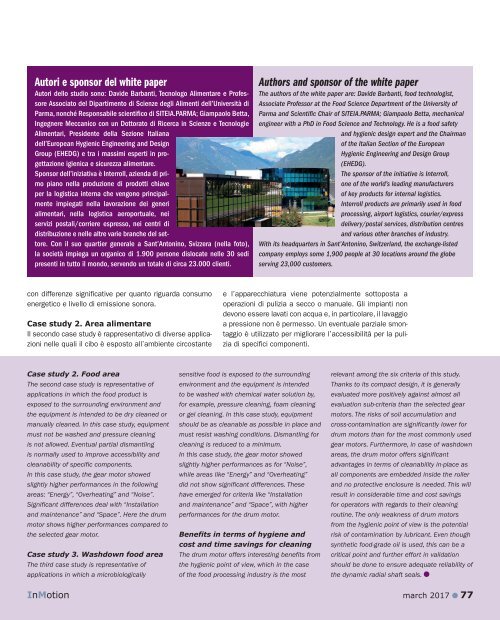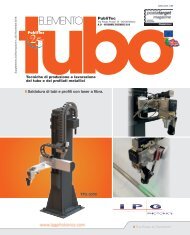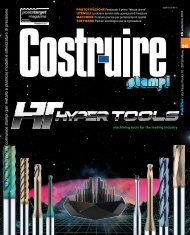PUB_INMOTION_n31_MARZO_2017_Interno96pag_160_PlanciaLR
Create successful ePaper yourself
Turn your PDF publications into a flip-book with our unique Google optimized e-Paper software.
Autori e sponsor del white paper<br />
Autori dello studio sono: Davide Barbanti, Tecnologo Alimentare e Professore<br />
Associato del Dipartimento di Scienze degli Alimenti dell’Università di<br />
Parma, nonché Responsabile scientifico di SITEIA.PARMA; Giampaolo Betta,<br />
Ingegnere Meccanico con un Dottorato di Ricerca in Scienze e Tecnologie<br />
Alimentari, Presidente della Sezione Italiana<br />
dell’European Hygienic Engineering and Design<br />
Group (EHEDG) e tra i massimi esperti in progettazione<br />
igienica e sicurezza alimentare.<br />
Sponsor dell’iniziativa è Interroll, azienda di primo<br />
piano nella produzione di prodotti chiave<br />
per la logistica interna che vengono principalmente<br />
impiegati nella lavorazione dei generi<br />
alimentari, nella logistica aeroportuale, nei<br />
servizi postali/corriere espresso, nei centri di<br />
distribuzione e nelle altre varie branche del settore.<br />
Con il suo quartier generale a Sant’Antonino, Svizzera (nella foto),<br />
la società impiega un organico di 1.900 persone dislocate nelle 30 sedi<br />
presenti in tutto il mondo, servendo un totale di circa 23.000 clienti.<br />
Authors and sponsor of the white paper<br />
The authors of the white paper are: Davide Barbanti, food technologist,<br />
Associate Professor at the Food Science Department of the University of<br />
Parma and Scientific Chair of SITEIA.PARMA; Giampaolo Betta, mechanical<br />
engineer with a PhD in Food Science and Technology. He is a food safety<br />
and hygienic design expert and the Chairman<br />
of the Italian Section of the European<br />
Hygienic Engineering and Design Group<br />
(EHEDG).<br />
The sponsor of the initiative is Interroll,<br />
one of the world’s leading manufacturers<br />
of key products for internal logistics.<br />
Interroll products are primarily used in food<br />
processing, airport logistics, courier/express<br />
delivery/postal services, distribution centres<br />
and various other branches of industry.<br />
With its headquarters in Sant’Antonino, Switzerland, the exchange-listed<br />
company employs some 1,900 people at 30 locations around the globe<br />
serving 23,000 customers.<br />
con differenze significative per quanto riguarda consumo<br />
energetico e livello di emissione sonora.<br />
Case study 2. Area alimentare<br />
Il secondo case study è rappresentativo di diverse applicazioni<br />
nelle quali il cibo è esposto all’ambiente circostante<br />
e l’apparecchiatura viene potenzialmente sottoposta a<br />
operazioni di pulizia a secco o manuale. Gli impianti non<br />
devono essere lavati con acqua e, in particolare, il lavaggio<br />
a pressione non è permesso. Un eventuale parziale smontaggio<br />
è utilizzato per migliorare l’accessibilità per la pulizia<br />
di specifici componenti.<br />
Case study 2. Food area<br />
The second case study is representative of<br />
applications in which the food product is<br />
exposed to the surrounding environment and<br />
the equipment is intended to be dry cleaned or<br />
manually cleaned. In this case study, equipment<br />
must not be washed and pressure cleaning<br />
is not allowed. Eventual partial dismantling<br />
is normally used to improve accessibility and<br />
cleanability of specific components.<br />
In this case study, the gear motor showed<br />
slightly higher performances in the following<br />
areas: “Energy”, “Overheating” and “Noise”.<br />
Significant differences deal with “Installation<br />
and maintenance” and “Space”. Here the drum<br />
motor shows higher performances compared to<br />
the selected gear motor.<br />
Case study 3. Washdown food area<br />
The third case study is representative of<br />
applications in which a microbiologically<br />
InMotion<br />
sensitive food is exposed to the surrounding<br />
environment and the equipment is intended<br />
to be washed with chemical water solution by,<br />
for example, pressure cleaning, foam cleaning<br />
or gel cleaning. In this case study, equipment<br />
should be as cleanable as possible in place and<br />
must resist washing conditions. Dismantling for<br />
cleaning is reduced to a minimum.<br />
In this case study, the gear motor showed<br />
slightly higher performances as for “Noise”,<br />
while areas like “Energy” and “Overheating”<br />
did not show significant differences. These<br />
have emerged for criteria like “Installation<br />
and maintenance” and “Space”, with higher<br />
performances for the drum motor.<br />
Benefits in terms of hygiene and<br />
cost and time savings for cleaning<br />
The drum motor offers interesting benefits from<br />
the hygienic point of view, which in the case<br />
of the food processing industry is the most<br />
relevant among the six criteria of this study.<br />
Thanks to its compact design, it is generally<br />
evaluated more positively against almost all<br />
evaluation sub-criteria than the selected gear<br />
motors. The risks of soil accumulation and<br />
cross-contamination are significantly lower for<br />
drum motors than for the most commonly used<br />
gear motors. Furthermore, in case of washdown<br />
areas, the drum motor offers significant<br />
advantages in terms of cleanability in-place as<br />
all components are embedded inside the roller<br />
and no protective enclosure is needed. This will<br />
result in considerable time and cost savings<br />
for operators with regards to their cleaning<br />
routine. The only weakness of drum motors<br />
from the hygienic point of view is the potential<br />
risk of contamination by lubricant. Even though<br />
synthetic food-grade oil is used, this can be a<br />
critical point and further effort in validation<br />
should be done to ensure adequate reliability of<br />
the dynamic radial shaft seals. l<br />
march <strong>2017</strong> l 77





